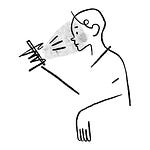The more digital our culture becomes, the more it's good to resist with the little things we care about. Like pen and paper.
Tsh’s free weekly email, 5 Quick Things
This is The Good List — I’m Tsh Oxenreider.
This is a thing.
Second to the new year, one of my favorite times of the year, honestly all the way through college, was the start of a new school year. It’s actually widely known (at least in the book publishing industry) as the second new year, and I can see why. Even if we’re not students anymore, or have any kids in school, our western northern hemisphere anchors itself in the school calendar. We tend to think in semesters and holiday breaks, and who among us didn’t have that shock during our first real jobs, when we realized we no longer had summer breaks?
One of my favorite reasons for the start of a new school year was the excuse to get fresh school supplies: books with uncreased covers, fresh spiral notebooks full of unused paper, a full set of crayons. A bouquet of newly-sharpened pencils would be the most charming gift.
I’m still like this, which is why I love getting a new journal, be it at the start of a school year or the new year. And I’d wager I’m not alone.
There’s just something hopeful about the start of a new journal, empty and waiting for our thoughts. I’ll be honest, when I was younger, in college and just after, I used to keep a journal on my nightstand because, quote, that’s what good adults do. They keep journals. But I wasn’t really sure what to do with one, so I’d scribble some random thoughts for a while, maybe write out my prayers for a time to keep me focused in the morning, but then I’d peter out. I’d lose interest in the journal, and then whenever the next school year or new year started, I’d get a hankering for a nice, new journal, and I’d rinse and repeat that cycle.
But now, I carry my journal with me everywhere. I don’t think I’d know what to do if I didn’t have it with me during work, or when I needed to think through something. My journal has become my second brain. But this is because I’ve figured out how to use it so that it’s a useful tool for me, not this thing I feel like I’m supposed to like using. I actually use it, and I don’t worry about whether I’m doing it right.
After several years of trying to keep track of my to-do list and other things digitally, for the past 3 years or so, I’ve come to fully, completely embrace the beauty of an analog-digital hybrid because it just works for me. I keep my calendar digital, using the free Google Calendar system (mostly because I can also share it with my husband, kids, and assistant, but also because I create infinite calendars and toggle different ones to seen and unseen with just a click). I also menu plan online because almost all my recipes are online, and I use an app that helps me drag-and-drop everything in just a few minutes’ time (more on that gem in a future episode).
But just about everything else — my daily to-do lists, my book outlines and work brainstorms, my coaching notes, my lists of books I want to read and movies I want to watch, even my list of things to look up the next time I’m online — it’s all captured in a physical journal with good old paper and pen.
I use a digital-analog hybrid as my journaling system, meaning, I use a few online and digital tools, but mostly I rely on pen and paper in my journal. Here’s why.
I don’t know about you, but the more digital our culture becomes, the more I want to resist in little things that keep me moving forward with things I care about. Most of the internet is intentionally hard-wired to be distracting because everything is vying for our attention. Yet the whole purpose of capturing to-do lists and thoughts I don’t want to forget is… so I don’t forget them. How often have you opened a tab on your internet browser and forgotten what you were going to do next? Or you open your browser to do one quick thing, but something else immediately grabs you like a moth to a flame, and 30 minutes later, you have no memory of why you got online in the first place? Me too. An analog journal helps me focus.
It also slows me down. Writing down my to-do list takes just a few minutes longer than typing it, but that act is enough of a buffer to keep me from overdoing a daily to-do list. It’s way too easy for me to type 30 things I could do in a day. I can feel it in my hands if I start writing too much with a pen.
There’s also studies that tell us we remember and learn more when we write things down vs. typing it. When I write things down in my journal, I’m way more likely to remember it. It’s just how it is.
I’ll bet most of these things are true for you, too. So if you’re in the mood to try a new journal, I’ve got a few recommendations.
The first one is my current favorite, and the one I absolutely love — that’s the FFP from Michael Hyatt & Co. These are quarterly journals, so if you like starting fresh every few months, that’s built into the system. Then again, you may not prefer that, so your mileage may vary there. In short, this is a goal-focused planner, with pages that have turned out to be nearly perfect for how I use my journal (I simply customize the rest to make it work for me). The goal pages in the front are just about the best thing ever, as well as the weekly preview pages in between each week’s daily pages — I started using these just last year, and I’m surprised how helpful they are. Weekly previews allow you to slow down at the end of each week to reflect on what went well, what didn’t, and what you can keep doing or tweak moving forward. The whole planner really does have your focus in mind, so right now, it’s my first choice, especially as a solopreneur. If you’re one as well, or a small business owner, or honestly, in just about any work field, I recommend giving FFP a look.
My second favorite planner on the market right now is the Sacred Ordinary Days planner, and between you and me, I wish there was a way to let the Full Focus Planner and this planner have a love child, because that’d be my favorite all-time planner. Sacred Ordinary Days is perfect if you’re liturgically minded, or want to be — it fuses the sacred beauty of the liturgical calendar with the everyday reality of our need to plan and be productive. Now, because it leans into the liturgical calendar, it actually starts the first week of Advent, whenever that is, not January 1. So if you’re listening to this episode when it first drops, that means the current one started on December 1, 2019. That doesn’t mean you can’t still try it out, though! In fact, that’s true with any of these — the new year has most likely already passed. Don’t let perfectionism keep you from trying new things. It doesn’t matter if you don’t start a journal right at the start of the year.
A third one on the market I’m a fan of is the Monk Manual. It provides a really thoughtful approach to your to-do list, helping you remember what you really care about as you go through the little daily errands and tasks you have to do. It’s divided into days, weeks, and months, and leans heavily into a seasonal approach to work — its tagline is “a system for being and doing.” It really is a lovely system; very straightforward, very holistic-focused. I dig it.
And lastly, I’d be remiss if I didn’t mention the Bullet Journaling method, which is insanely popular and there’s a good chance you’ve heard of it. You can use any journal you like because it’s a system more than a specific journal or planner (though they do have those now). There’s a lot of info out there on how to BuJo, but in my experience, it’s one of those things you can read and read and read about, and accidentally never get around to trying it out of fear of somehow doing it wrong. The best approach is just to try it out, then tweak, add, edit, and change as you go. I actually use somewhat of a BuJo approach in my FFP, which I may talk about in a future episode. For several years, I bullet journaled using a blank journal (either a moleskine or leichtturn), and it worked great — so it could be a good option for you.
The point in all this: a good journal is a really good thing, and when you find a system — preferably analog, with pen and paper — that works well for you, lean into it. Make it work for you. You’re the boss; let it be one of your most useful tools in your arsenal. A good, customizable, just-right-for-you planner really can make your life better.
I’ve got links to all these things in the show notes of this episode, including codes and discounts for a few of these, so look for those links.
[PHONE RING]
Hi, this is Marie from New Haven, Connecticut. And I've just loved listening to The Good List, so I've been trying to build my own for a long time and I actually have one of each.
So the thing that has made my life so much better are the right shoes. I walk to work about two miles each way every day, and I need to have a pair of shoes that are not tennis shoes, but look still professional but can handle sort of a good urban environment. I bought a pair of Frye's shoes a few months ago, and despite the much higher cost, I know that they will last. There's actually a cobbler in town and he says they last forever, and I’ve come to love them, and they look great, and they make me feel great.
A habit: I've been keeping a five-year Journal. I'm on year two and I just absolutely love seeing what I was doing a year ago on that date. Just to take a second in writing this down a couple of things that I did that day or what my kids did or something that I saw brings back all these wonderful memories.
Work of art: For my 40th birthday, I bought myself for Karen Hallion prints off Etsy, and I got Hermione, Princess Leia, Anne of Green Gables, and Diana from Wonder Woman, and they're in my office — they’re so inspiring and they make me feel great.
Then a philosophy or an idea… I love the slow movement, especially in academia and the idea that we shouldn't be so rushed and work. Once we have the privilege of being able to do that in academia, we can help change the system. That has influenced how I approach my work and how I advocate for other scholars in my field, to slow down in our work and our life — like not answering emails on the weekends, which is something that I've done for a couple of years now, and it has been wonderful. Anyway, love youf show.
[ENDING]
The Good List is a brand-new podcast, as you know, and if you’re liking it so far, I’d love you to consider making it one of your weekly must-listens. The best way to do that is to subscribe to the show, so you never miss an episode. The Good List can be found most likely wherever you already listen to podcasts — Apple, Spotify, Overcast, Stitcher, Google, iHeart Radio, Alexa — so search in those places for either “the good list” or my name, “tsh oxenreider,” and you should find it. Then click that subscribe button, and you’re good to go. You can also find easy subscribe links to all these places at thegoodlistshow.com. My goal is to make this short little show one of your favorite go-to boosts of encouragement for your week — episodes are short on purpose, and are as laser-focused as possible to respect your time.
So to subscribe, and to find the show notes of this episode, #4, head to thegoodlistshow.com, where I’ve got links to all the journals and planners in this episode, including codes and discounts for a few of them. This is also where you can sign up for my free weekly email, 5 Quick Things, and where you can read a full transcript of this episode. Again, all of this is at thegoodlistshow.com.
I do occasionally hang out online every now and then. I’m on twitter @tsh, and I’d love you to say hi, and to tell me what’s on your good list right now. You can also find more of my in-depth, longer-form writing at Books & Crannies, my Substack letter. You can find a link to that as well at thegoodlistshow.com.
And don’t forget, I’d love to feature what’s on your good list right here on the show! Simply record yourself from your phone, stating your name, where you’re from, and what idea, work of art, habit, or thing is making your life just a bit better. Then email the voice file to hi@tshoxenreider.com. You can also call and leave a voicemail at (401) 684-GOOD, and I promise it goes straight to voicemail; you won’t have to talk to anyone. Again, reminders on how to do all this is at thegoodlistshow.com, so just head there, and you’ll get squared away.
Thanks so much to Marie, for sharing what’s on her Good List. Music for the show is by Kevin MacLeod, and thanks, as always, to Caroline TeSelle for her help, as well as my furry intern, Ginny. I’m Tsh Oxenreider — thanks for listening to The Good List.










A Journal — Whatever Works